Aquarium Conditioned
Red Coris Wrasse
coris gaimard, Fiji
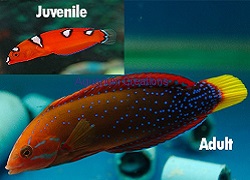 YouTube Video Red Coris Wrasse
YouTube Video Red Coris Wrasse
Description:
The Red Coris Wrasse, also known as the Clown Wrasse, Red Labrid, or Yellowtail Coris, is found in the Indo-Pacific and Hawaii. Adult specimens in the wild can easily grow to a foot, but in an aquarium, they rarely exceed 6-8 inches. The juvenile and adult appearances vary greatly. As a youth, the body color is orange with white stripes or spots across the back. The stripes and fins are outlined in black. In adulthood, the body takes on a beautiful speckled blue coloration, the fins are decorated with bright yellows, reds, and blues, and the face is orange with green stripes. The male has a light green stripe on the body, just above the anal fin.
Tank Recommendations:
A 125 gallon or larger aquarium with live rock and a deep sand bed to which the fish can bury itself into when looking for protection or sleeping. Do not keep the Red Coris Wrasse on crushed coral or similar as their survival rate is low when a non-sand substrate is used. Perfect for the Fish Only or FOWLR tank. When juvenile Red Coris are safe with almost any fish or invertebrate that will not eat them. However once an adult it may begin eating a wide array of invertebrates, including snails, sand dwelling bivalves, hermit crabs, crabs, chitons, shrimp, isopods, amphipods and sea urchins. Larger individuals regularly flip over corals and play with small rocks. Tank-mates recommended should be moderately aggressive, active fish, including Angels, Surgeon Tangs, and smaller less aggressive Triggers.
Food and diet:Feed a varied diet of chopped meaty foods such as fresh shrimp, brine shrimp, squid, clams, chopped beef heart. For the health of your fish it is always desirable to soak all fish food including algae with vitamins to help keep your fish healthier and less susceptible to disease. Try to feed at least two to three times a day In the wild they feed constantly while performing their normal cleaning activities, in the aquarium they should be fed several times a day.
Reef Compatability: Not recommended
Level of Care: Moderate
Approximate Purchase Size:Juvenile: Small 1" to 1-3/4" Medium 1-3/4" to 2-1/4" Large 2-1/4" to 3-1/2"
Adult: Medium: 3" to 4" Large: 4" to 6" XLarge 6" to 7" XXLarge 7" to 9"
|
Small Juvenile$39.99
Medium Juvenile$39.99
Large Juvenile$49.99
Medium Adult$59.99
Large Adult$79.99
XLarge Adult$149.99
XXLarge Adult$279.99
|
Aquarium Conditioned
Blue Head Wrasse
Thalassoma bifasciatum
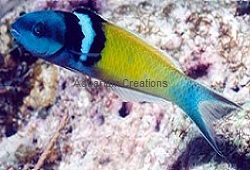 YouTube Video of Bluehead Wrasse
YouTube Video of Bluehead Wrasse
Description: The Bluehead Wrasse (Thalassoma bifasciatum) is a fish common to the Caribbean and tropical West Atlantic Ocean. Bluehead wrasses have a small adult size at just about 7 inches. This combined with their high activity level, and brilliant adult coloration make them a very desirable fish in the aquarium trade. This is the most common wrasse in the Tropical Eastern Atlantic, but because they aren't known all that well, they are somewhat uncommon in the hobby, which is a shame for such a gorgeous, hardy fish. They can be found at a variety of depths, ranging from the surface down to about 120 feet. They are generally found around reefs. Bluehead wrasses have been known to associate with Condylactis anemones, especially as juveniles, but adults may also use the anemones for shelter if the anemone is large enough. Little is known as to whether these wrasses have similar defenses as clownfish to the nematocyst sting of the anemone. More study is needed to decide whether this relationship is symbiotic (both parties gain) or parasitic (one party gains).
Tank Recommenations:
A 75 gallon or larger aquarium with plenty of live rock . Larger, gregarious tankmates are recommended since the Bluehead Wrasse will demonstrate territorial behaviour and harass new additions to the aquarium. If possible, the Bluehead Wrasse should be the last fish added to the aquarium. Since the Bluehead Wrasse sometimes becomes territorial in the aquarium therefore because of the aggressive behavior either place most of your fish in the tank at the same time, or make the Bluehead Wrasse your last addition to the tank. One other possibility is to rearrange the entire tanks liverock so all the fish are once again finding a new home (territory). This works very well. Wrasses are known jumpers so the aquarium top should be covered.
Food and diet:
Feed a varied diet of chopped meaty foods such as fresh shrimp, brine shrimp, squid, clams, chopped beef heart. For the health of your fish it is always desirable to soak all fish food including algae with vitamins to help keep your fish healthier and less susceptible to disease. Try to feed at least two to three times a day In the wild they feed constantly while performing their normal cleaning activities, in the aquarium they should be fed several times a day.
Reef Compatability:
Not recommended
Level of Care:
Easy
Approximate Purchase Size:
Medium 2" - 4" Large 4" to 6"
|
Medium $29.99
Large $39.99
|
Aquarium Conditioned
Dragon Wrasse
Novaculichthys taeniourus
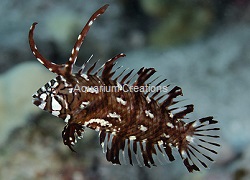
YouTube Video of Dragon Wrasse Moving Rock
Description:
The Dragon Wrasse is native to the Indian Ocean, Pacific Ocean, Red Sea, Panama, as far north as the Hawaiian islands and Micronesia. It can also be found in the Eastern Pacific from the Gulf of California to Panama, across to Japan. The sand is also a source of refuge for this and most other wrasses. When it feels threatened, both the adult and juvenile Dragon Wrasse will dive into the sand and wiggle their way to safety. It is amazing how far this wrasse can travel under the sand in a short amount of time.
Dragon Wrasse fish are unusual in that juveniles look completely different from adults. Young Dragon Wrasse are first nicknamed Reindeer Wrasse because of their unique appendages that look something like horns. Juveniles' bodies are flat and green colored with long pelvic fins and dorsal fin filaments. As the juveniles glide and dip near the sea floor they look very much like seaweed, providing them with useful camouflage. If they are spotted by a predator, Reindeer Wrasse will actually dive head first into the sand and hide until the danger passes. As they grow up, Reindeer Wrasse lose their unique appendages and filaments as well as their special name. The coloring on their bodies changes to a Brown with a honeycomb pattern. Their tails become white with black edging. As adults, these fish are no longer Reindeer Wrasse but are now official adult Dragon Wrasse.
While juveniles can live peacefully in a community tank, adult Dragon Wrasse will eat snails, crabs, and small aquarium fish are also prey. Even those fish that are usually able to hide from predators will find it hard to escape from a fish that can (and does) turn over rocks and search inside caves to find a meal. In addition to these considerations,
Tank Recommendations:
It should reside in a 180 gallon or larger aquarium with a 2-4 inch sandy bottom in which it can submerge itself since it sleeps in the sand. Somewhat agressive, therefore only put in with other aggressive tank mates. It's also important to know that Dragon Wrasse will, as they grow up, become "king" of its territory. If you plan to add these fish to a tank with any other fish, it must be the last fish in the tank; otherwise, it will fight with tankmates. Possible tankmates (to be added to the tank before introducing the Dragon Wrasse) include groupers, hawkfish, snappers, grunts, and triggerfish. If you're not eager to play host to an aggressive tank, but think you'd enjoy watching a Dragon Wrasse as it metamorphoses and then learns to rearrange all the rocks and substrate in your tank, the easiest solution is to raise a single Dragon Wrasse from juvenile to adult in a live-rock tank that includes no other mobile animals. Finally, the Dragon wrasse like most wrasses are known jumpers so an aquarium top must be used.
Food and diet:
Feed a hearty diet of suitably bite-sized pieces of meaty foods that include fresh or frozen seafood, silversides, live or frozen brine and mysid shrimp, live grass or ghost shrimp, live black worms, and flake food. Smaller Dragon Wrasses can be fed chopped up pieces of meaty fares as well as Mysis Shrimp. It's best to feed these fish three times a day.
Reef Compatability:
Not Recommended
Level of Care:
Moderate
Approximate Purchase Size:
Small: 1-1/2" to 3"; Medium: 3" to 4"; Large: 4" to 6"
|
Small $39.99
Medium $49.99
Large $99.99
|
Aquarium Conditioned
Yellow Coris Wrasse
Halichoeres chrysus
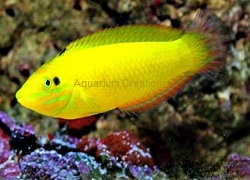
Description:
he Yellow Wrasse is known to the aquatic community under various names: golden rainbowfish, golden wrasse, yellow coris, and canary are several names that you will see. Its scientific name is Halichoeres chrysus and it hails from the Pacific Ocean to the edges of the eastern Indian Ocean. Yellow Wrasses are best known for their ability to eat fireworms, flatworms and pyramidillid snails. Yellow Wrasses will tolerate being kept in small groups and can be housed with other docile species of fish like flasher wrasses, Firefish, leopard wrasses and small gobies. They may even clean other fishes.
They are one of the more docile wrasses in the Halichoeres genus and are model citizens in your tank. They not aggressive towards other fish and nor are they particularly territorial. They do prefer a sandy substrate as they are known for burying themselves. They are a fairly hardy fish and a good choice for a beginner. They adapt well to aquarium life.
Recommended Tank size:
A 50 gallon or larger aquarium with a sealed lid, a 2-3 inch sandy bottom to hide under when stressed or frightened. It will eat fireworms and pyramidellid snails, protecting corals and clams. In addition, it may eat feather dusters, wild shrimp, tubeworms, and flatworms. It may also eat parasites off of tank mates. Wrasses are known jumpers so the aquarium top should be covered.
Food and Diet:
Feed a varied diet of chopped meaty foods such as fresh shrimp, brine shrimp, squid, clams, chopped beef heart. For the health of your fish it is always desirable to soak all fish food including algae with vitamins to help keep your fish healthier and less susceptible to disease. Try to feed at least two to three times a day In the wild they feed constantly while performing their normal cleaning activities, in the aquarium they should be fed several times a day.
Reef Compatability:
Won't bother corals, but this fish feeds on a wide array of invertebrates, (eats great!) including snails, sand-dwelling bivalves, hermit crabs, crabs, chitons, shrimp, isopods, amphipods and sea urchins. Not recommended for the reef aquarium.
Level of Care:
Moderate
Approximate Purchase Size:
Small 1-1/2" to 3" Medium 3" to 4" Large 4" to 6"
|
Small $29.99
Medium $39.99
Large $69.99
|
Aquarium Conditioned
Pastel Green Wrasse
Halichoeres chloropterus
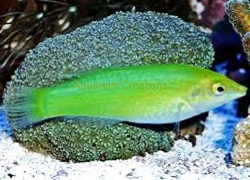 YouTube Video of the Green Wrasse
YouTube Video of the Green Wrasse
Description:
The Pastel Green Wrasse is also referred to as the Green Wrasse or Green Coris Wrasse. They are great at controlling pests like fireworms and pyramid snails. In addition, it may eat feather dusters, wild shrimp, tubeworms, and flatworms. Green Wrasse should be peaceful to all fish in your tank. Wrasses from the Halichoeres and Thalassoma genera are some of the most active in the wrasse group. Most are narrow and torpedo-shaped. While Thalassoma wrasses are often in the upper to mid-water ranges of the aquarium, Halichoeres wrasses are often closer to the substrate or rockwork, especially when young.
They also bury themselves in the substrate when resting or threatened. Because of this behavior, Halichoeres wrasses are often confused with some Coris wrasses. Thalassoma wrasses are also sometimes known as "paddlefin wrasses" due to their use of their pectoral fins while swimming. Longer aquariums with plenty of swimming room are best for these wrasses.
Recommended Tank size:
The Pastel Green Wrasse can reach a fully grown adult size of around 7 inches and needs to be kept in an aquarium that is at least 55 gallons in size. Green Wrasses also require live rock and a sand bed that is 2-3 inches deep to hide under when stressed or frightened. Green Wrasses are known to be jumpers, so it is very important that your aquarium has a tight fitting cover with no holes that are large enough for them to jump through when spooked.
Food and Diet:
Feed a varied diet of chopped meaty foods such as fresh shrimp, brine shrimp, squid, clams, chopped beef heart. For the health of your fish it is always desirable to soak all fish food including algae with vitamins to help keep your fish healthier and less susceptible to disease. Try to feed at least two to three times a day In the wild they feed constantly while performing their normal cleaning activities, in the aquarium they should be fed several times a day.
Reef Compatability:
Not Recommended
Level of Care:
Easy
Approximate Purchase Size:
2" to 3"
|
$24.99
|
Aquarium Conditioned
Juvenile Twin Spot Wrasse
Coris aygula
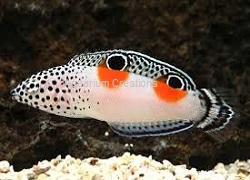
Description:
The Twin Spot Wrasse is a large and very active wrasse also known as the Clown Wrasse. It is a very large fish and is not recommended for aquarium life due to its size and the difficulty in keeping it. It is an interesting fish for its color patterns, which change markedly as it matures. The Twin Spot comes from the Indo-Pacific region, including the Red Sea. Juveniles have a white base with black spots on the front half and two large orange spots against a white background on the upper back. There is black trim on the fins. At about a foot in length, young adults change in color. Females retain the small black spots and become dark green/grey on the back half. Non breeding males are quite drab in appearance, while breeding males turn a dark green with bands of light green and blue. The second half of the body is marked by a distinct line where the color turns darker and there may be white banding at this intersection. The scales on the back half are more clearly defined. Breeding males will also have secondary color patterns through their fins.
Tank Recommendations:
Twin Spots will require a tank of more than 150 gallons with plenty of hiding and swimming areas. A deep, fine substrate should be provided for them to burrow in. Twin Spots are not reef safe. They have teeth that protrude from their mouth and are used to dig out prey from the sand. They also have large molars that crush shrimp, clams, crabs, snails and urchins.
Food and Diet:
Feed a varied diet of chopped meaty foods such as fresh shrimp, brine shrimp, squid, clams, chopped beef heart. For the health of your fish it is always desirable to soak all fish food including algae with vitamins to help keep your fish healthier and less susceptible to disease. Try to feed at least two to three times a day In the wild they feed constantly while performing their normal cleaning activities, in the aquarium they should be fed several times a day.
Reef Compatability:
Not Recommended
Level of Care:
Moderate
Approximate Purchase Size:
1-1/2 to 2-1/2" Medium 2-1/2" to 4" Large 4" to 6"
|
Small $49.99
Medium $79.99
Large $139.99
|

 YouTube Video Red Coris Wrasse
YouTube Video Red Coris Wrasse
 YouTube Video of Bluehead Wrasse
YouTube Video of Bluehead Wrasse


 YouTube Video of the Green Wrasse
YouTube Video of the Green Wrasse
